True to the brew
May 31, 2019
Eastern Washington is known for its vast fields of hops, variety of craft breweries and unique types of beer. With new breweries popping up left and right, CWU’s Craft Brewing Program has created the opportunity for students to break into the growing industry of craft brewing.
CWU is currently the only university in Washington that offers a four-year degree in craft brewing, with a focus on the science of brewing. CWU also offers a craft brewing certificate, which is a 16 credit interdisciplinary program designed to be completed in one academic year, or three quarters.
Senior Patrick Dillman is currently working on earning his brewing certifcate. He said his favorite part about the program is learning about the microbiology of brewing beer.
Dillman especially enjoyed working with the yeast. According to Dillman, most people assume that malt and hops are what makes up most of the favor of beer, but that is not always the case.
“There’s a lot of beers and a lot of different styles and a lot of favors that the yeast is really the star,” Dillman said.
According to Eric Foss, instructional and classroom support technician III, the craft brewing program has almost 100 percent placement, so nearly all students have a job related to brewing upon graduating. Dillman said he is excited to see how brewing evolves in the future.
“There’s a lot of room for experimentation and some really good breweries are kind of looking to the future and…just finding lots of fun new things to do with beer,” Dillman said.
The craft brewing program currently has about 15 students, according to Foss. There are students and instructors brewing in the brew lab nearly every day of the week, getting hands on experience with brewing their own beer.
“It’s surprisingly easy to learn, hard to master but a lot of fun,” Dillman said.
The grains used when brewing make up the color and favor of the beer. Barley is the grain most commonly used when brewing beer, although other grains like wheat and rye can be used for different favors. The grains can be malted or unmalted depending on the favor profile the brewer wants.
Malt extract is then added to the liquid, which provides the sugars necessary for the fermentation process. The sugars interact with yeast, which ferments the suga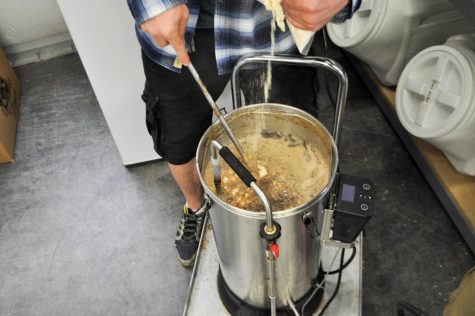 rs into alcohol. The brewer must watch carefully to make sure the liquid does not boil over in the process.
rs into alcohol. The brewer must watch carefully to make sure the liquid does not boil over in the process.
Adding malt extract to the grain solution creates a liquid known as “wort.” The liquid is poured into a device called a refractometer, which measures the amount of sugar in the wort. This tells the brewer the specifi c gravity of the wort, which is used to calculate the alcohol by volume (ABV) of the finished beer. More sugar in the wort yields a higher ABV.
c gravity of the wort, which is used to calculate the alcohol by volume (ABV) of the finished beer. More sugar in the wort yields a higher ABV.
Foss, with the help of a few brewing students, was trying to make a German chocolate style beer. Although, no chocolate was used in the brewing process, certain grains can impart a chocolate-like favor and aroma to the 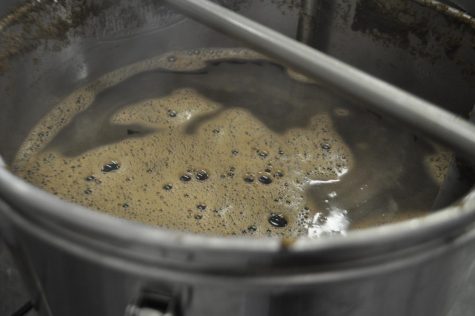 beer.
beer.
Foss, instructional and classroom support technician III, adjusts the temperature of a five-gallon electric brewing system called the Grainfather. Grains are steeped in the kettle to extract enzymes and flavor. The temperature is raised to 130 degrees for about half an hour before the grains are remo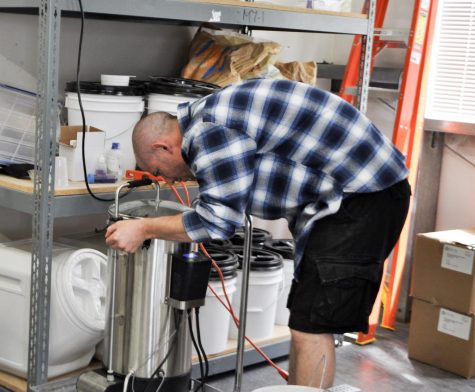 ved and strained.
ved and strained.
The kettle is then brought to a boil. The boiling time varies based on the type of beer that is being made. Hops can be added at various intervals throughout the boiling process depending on the desired flavor pr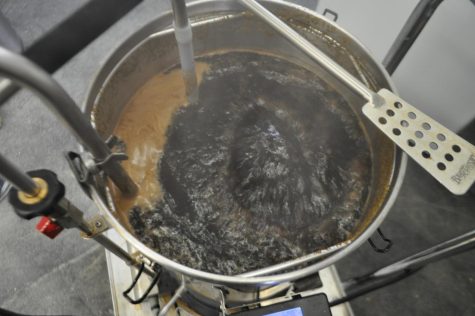 ofile.
ofile.
Hops impart flavor, bitterness and stability to the beer. They can be bought in several forms, such as whole cone, pellets or extracts. The hops can be added at the beginning of the boiling stage to add bitterness to the beer, and can also be added at the end of the 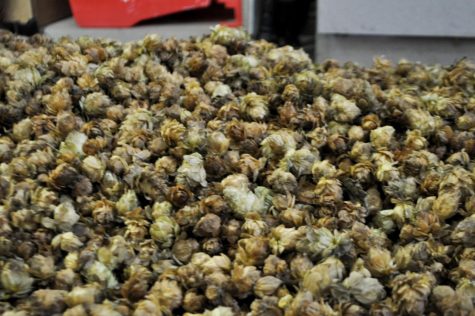 boiling process to add flavor and aroma.
boiling process to add flavor and aroma.
The wort needs to be cooled by bringing its temperature down as quickly as possible. The most efficient way to do that is with a wort chiller. The wort chiller is immersed in the liquid and cold water runs through the coils, cooling the wort to a temperature at which yeast can be added.
Once cooled, the wort is transferred to a fermentor. Water is added to bring the level back to five gallons after much of the liquid has evaporated. The brewer then adds yeast, which converts the sugars in the wort into alcohol. The fermentor is then sealed and stored in a cool place so the beer can ferment, a process which usually takes one to two weeks.
Students brew beers of all kinds, flavors and colors in the brewing program and B.R.E.W. Club. Beer is typically brewed in one or five-gallon batches. The beer is often used as examples in brewing classes or in sensory analysis. B.R.E.W. Club, which stands for Beer Research and Education of Washington, is open to students of all majors and ages.


